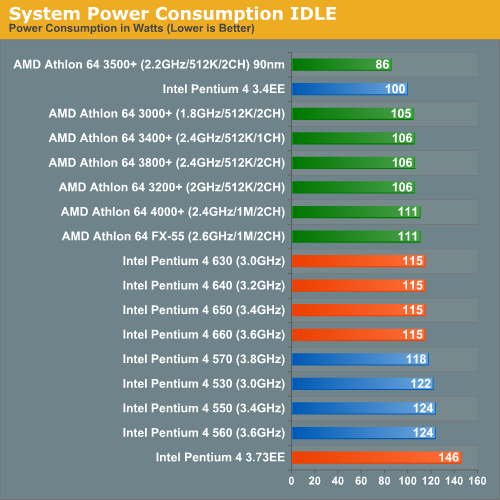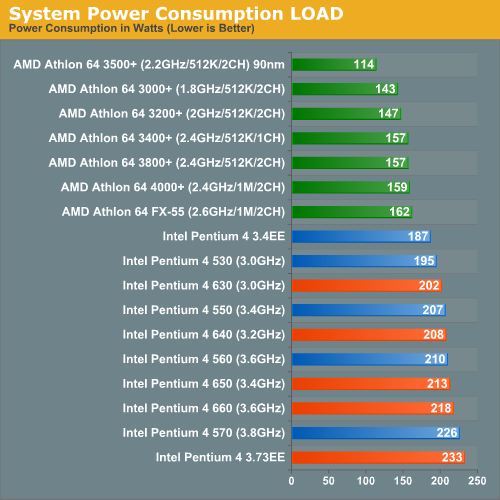Intel Pentium 4 6xx and 3.73EE: Favoring Features Over Performance
by Anand Lal Shimpi & Derek Wilson on February 21, 2005 6:15 AM EST- Posted in
- CPUs
Lower Power Consumption
Over time, any good chip manufacturer will be able to tweak and fine tune their manufacturing process to improve yields. The first 90nm Pentium 4s have been in production for over a year now, and thus it's not too far of a stretch to think that today's 90nm Pentium 4 6xx CPUs are being built on a higher yield 90nm process. In addition to normal tweaks in any manufacturing process, the new 6xx series introduces a handful of power saving techniques that help to reduce overall power consumption of the chip.
First introduced in the 5xxJ series, the Enhanced Halt State (C1E) and Thermal Monitor 2 are both mechanisms included in the 6xx series to reduce power.
Whenever the OS executes the halt instruction, the CPU enters what is known as the halt state. Architecturally what's going on in a halt state is the clock signal is shut off to the CPU for some period of time, with no clock signal none of the logic in the chip will do anything and thus power consumption is reduced. Performance is also significantly reduced, however the halt instruction isn't usually called during application usage, so the performance aspects of the halt state aren't very important.
The problem with the halt state is that it does nothing to reduce voltage, only current draw by stopping clocks from going to the CPU. Since Power varies linearly with both current and voltage (P = I * V), you're effectively only addressing half of the problem. The Enhanced Halt State, as Intel calls it, does two things - it reduces the clock speed of the CPU by decreasing the clock multiplier down to its minimum value (on the 6xx series that's 14x, or 2.8GHz) then reducing the voltage. The clock speed is reduced and then the voltage is dropped, to maintain stability.
Intel insists that the enhanced halt state is a significantly lower power state than the conventional halt state, thanks to the reduction in voltage in addition to the reduction in clock speed. While the standard halt state causes a linear reduction in power, Intel's enhanced halt state causes an exponential decrease in power, potentially offering better power savings than the standard halt state. The real world impact obviously depends on how idle your system happens to be.
When the Pentium 4 was first launched there was a lot of bad journalism out there about how it would overheat and reduce its clock speed significantly thanks its integrated Thermal Monitor. If the Pentium 4 sensed that it was operating outside of safe temperatures, its Thermal Monitor can reduce the effective clock speed of the CPU by approximately 50% - once again by cutting clocks to the CPU. In reality, the Pentium 4's clock throttling never actually came into play unless your fan stopped, or your heatsink fell off. More recent Pentium 4s however have been pushing the thermal envelope further and further, finally to the point where throttling can be a problem if you don't use high quality thermal compound and make sure your heatsink is absolutely secure. The performance reduction when the processor throttles is usually pretty significant.
With the new 6xx series of CPUs, Intel introduces Thermal Monitor 2 (TM2) which, as in the case of the enhanced halt state, reduces clock speed (to 2.8GHz) and voltage as well. The performance impact due to TM2 is much less than the original implementation, so it can actually be triggered during normal use without an overly noticeable loss of performance. However if reducing the clock speed and voltage isn't enough, the CPU will still shut itself down in order to avoid any damage just like the other Pentium 4s did.

Yes, we ran Windows Media Encoder 9 with the fan off for 5 minutes.
But both the Enhanced Halt State and TM2 were introduced in the 5xxJ CPUs, what's new to the 6xx series is the Enhanced Intel SpeedStep Technology (EIST). What EIST does is very similar to AMD's Cool'n'Quiet, it is demand based reduction in CPU clock speed and voltage. Using the same mechanism of adjusting clock speed and voltage, based on the application demand, the Pentium 4 6xx will dynamically increase/decrease its clock speed between 2.8GHz and its normal operating frequency, as well as voltage, in order to optimize for power consumption.
Because of the way EIST (and AMD's Cool'n'Quiet) works, there's inherently a drop in performance. The idea is this - if you're performing a task that's not using 100% of the CPU, the CPU will operate at a slightly reduced frequency in order to conserve power. So while some tasks will require that the system run at full speed, others will run at speeds as low as 2.8GHz. With a minimum multiplier of 14x, slower Pentium 4 6xx CPUs won't get a huge benefit from EIST. For example, the Pentium 4 630 runs at 3.0GHz, meaning the drop down to 2.8GHz isn't really going to conserve a ton of power, nor decrease performance all that much.
AMD's Cool'n'Quiet appears to be more flexible, as it can reduce the clock speed all the way down to 800MHz.
How much of a performance impact does EIST result in? Using a 100% load test such as Windows Media Encoder wouldn't tell us much, as EIST would never really kick in. But something like Winstone where the CPU load is varied, is a much better indication - without EIST, the Pentium 4 660 was approximately 5% faster in Business Winstone than with EIST enabled. Under Doom 3, there was no performance difference.


Intel Officially Adds 64-bit
The Pentium 4 600 series and 3.73EE officially enables Intel's 64-bit extensions to x86 (EM64T, Intel's version of AMD's x86-64). We will have a full look at the 64-bit performance of both AMD and Intel's implementations as soon as Microsoft Windows XP x64 is released.










71 Comments
View All Comments
johnsonx - Monday, February 21, 2005 - link
Is there no merit at all in running a few A64 vs P4 6xx benchmarks with the current RC build of XP x64? While I've found too many things I need don't work with XP x64 to use it, I did see that 3dMark03 ran fine. I know 3dMark itself isn't 64-bit, bit it does making heavy use of 64-bit DirectX and graphic driver calls. There must be a few more apps and games that could be called on...Maybe just limit the benchies to two processors, say an A64 3500+ vs. a Pentium 4 650, running the same benchmarks in 32-bit and 64-bit Windows, using just one GeForce 6xxx and one Radeon X8-something.
It'd just be interesting and useful to see which processor runs 64-bit code better, both absolutely and compared to each processor's 32-bit performance.
When the final release version of XP x64 does come out, it may be interesting to have benchmarks from the RC version to see what's improved (though I agree it wouldn't actually be useful in any practical sense).
Or perhaps Anandtech knows something I don't, like the release XP x64 is so close that running benches on the RC would be moot....
SLIM - Monday, February 21, 2005 - link
#30 and 36Hans is right, the 3000 and 3200 cores in the graphs are not available in retail (downclocked 130nm cores) and are meant to show power consumption scaling with speed increases. It's unfortunate that they left out the more interesting comparison (the 130nm 3500+). The only 90nm AMD chip in the power graphs is the 3500+.
coldpower27 - Monday, February 21, 2005 - link
Very strange your the only guys so far that show an increase in power consumption of the P4 6xx Series over the 5xx Series.Regs - Monday, February 21, 2005 - link
Wow, a lot of good comments here. mlittl3, most of the Anandtech's population know that the EE's are just overpriced Northwood's on steroids (Big heads, small balls). And the crayon wax melting comparison made me laugh out loud.I just find it funny Intel is trying to slap on everything but the kitchen sink on these processors to make them more appealing. What's next? Are they going to come with a microwave toaster oven combo? With all do respect to Intel, to add on such features is not an easy thing to do at a engineering level but once again I feel that their marketing team is still running the show.
But what is AMD doing while Intel performs CPR on their Prescott's? All this news on Intel for the past few months left me nostalgic in what AMD is doing behind the scenes. SSE3 was their latest slap-on feature, but as we saw in your recent AMD article it offered little to no performance gain. AMD's next core has to offer lower L1-l2 Cache latencies. This is the only way I see AMD cornering Intel's Cores performance in every application. But im afraid we won't see any such thing until long-horn comes out in a few years. Until now we have to settle for worthless add-ons features for the desk-top consumers while we see both Intel and AMD battle the server market where Intel is mostly threatened.
HardwareD00d - Monday, February 21, 2005 - link
In Soviet Russia, Prescott melts YOU!miketheidiot - Monday, February 21, 2005 - link
why do the 3000 and 3200 have signifigantly higher power consumption than the 3500? I thought all 3200 and 3000 are also built on 90nm soi.RadeonGuy - Monday, February 21, 2005 - link
Even With All the processors haveing 2mb cache they still suck assHans Maulwurf - Monday, February 21, 2005 - link
#30 I think the 3000 and 3200 are not really Winchester cores. Maybe clocked down 130 nm cores.I´m interested in the memory timing of the A64. Is it 1T or 2T? This is an important information, you should always(!) give it the configuration part of reviews.
DerekWilson - Monday, February 21, 2005 - link
One thing to remember about out power tests --We measure power draw at the wall. Power supplies are inefficient and magnify power draw at the wall. Power input to the PSU does not scale proportionally to power output.
Brian23 - Monday, February 21, 2005 - link
I thought that all winchesters were 90nm SOI.